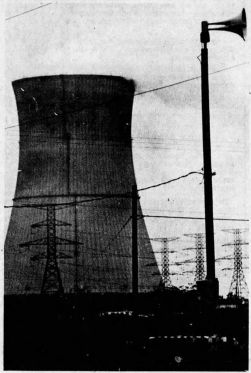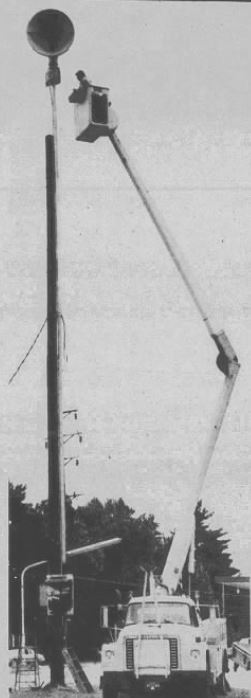Hurricane 130
ACA Hurricane 130
ACA Hurricane 130 MKII
| |
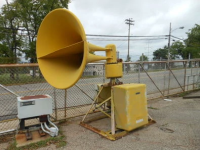 An ACA Hurricane 130 MKII on display at Werden Electric, complete with the blower. Siren is in operational condition. | |
| Company | Alerting Communicators of America |
|---|---|
| Produced | 1968-1981 |
| Type | Supercharged Rotational Electromechanical |
| Sound output | 130 dB @ 100 ft |
| Frequency | 60 Hz |
| Horsepower | 1-2 hp (chopper)
25-30 hp (blower)
|
| Voltage | (Chopper, rotor) 230 V AC
(Blower) 230/460 V 1 ph (chopper and rotator)
3 ph (blower)
|
| Blower horsepower | 25-30 hp |
| Succeeded by | ACA Penetrator |
The Hurricane 130 is a supercharged rotational outdoor warning siren designed by James E. Biersach, unveiled in 1968 alongside a large and diverse lineup of sirens from Alerting Communicators of America. Starting out with a square horn and an internal design that bottlenecked the siren's performance, the Hurricane went through many changes in design, sound, and overall functionality, despite being in production for only just over 10 years.
Hurricanes are extremely rare today, as all but one have been replaced by newer sirens. As of today, only a single ACA Hurricane 130 MKII remains in service, in Milwaukee, WI, with the rest abandoned in place or in private collections. A single example of a Hurricane 130 MKI is in private possession after its removal from Centralia, IL.
History and design
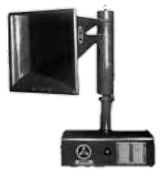
Hurricane 130
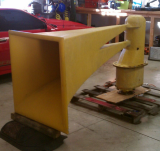
The Hurricane 130, also known as the Hurricane 130 MKI, was heavily inspired by the Thunderbolt, which had been seeing great success, and ACA wanted a siren which could compete with its performance. Like all of ACA's other sirens such as the Allertor 125, Cyclone, Screamer and Banshee, the Hurricane made use of all-fiberglass casting, which was brand new and prevented the siren from corroding from the elements.
The Hurricane 130 originally released with a square fiberglass horn with two throats leading to each rotor, a small, cylindrical rotator using a gear reduction drive, and the siren's standpipe was mounted directly on top of its horizontal roots blower. Like the Thunderbolt it competed with, the Hurricane utilized a 450 cfm, 10 psi tri-lobe Roots blower driven by a 25 hp AC motor, which supercharges the siren by forcing a large volume of air up the standpipe and into the rotors. Unlike the Thunderbolt's blower, the MKI Hurricane's blower was direct-drive without the use of belts. Like the Thunderbolt, the Hurricane is extremely quiet without the use of its blower due to poor air intake. The controls for the siren were mounted to the side of the blower box, which also had cooling vents. Originally, the siren was only available in 10/12 port dual tone. The MKI Hurricane uses a 2 horsepower motor with a fully custom frame enclosing the entire unit, making maintenance difficult. 36 of these units were produced.
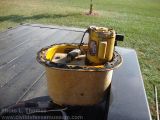
Around 1970, the MKI would be redesigned. The rotator was enlarged, now using a separate chain-driven rotator, with a 1/4 hp motor rotating the unit at 3 rpm. Unlike later models, the rotator spun along with the rest of the siren. This rotator design was more reliable and easier to maintain, with an access door on the side of the rotator housing for easier maintenance. In addition, 8/10 port dual tone became the standard, with 10/12, along with 8/12, 8/8, 10/10 and 12/12 port options being offered as well, although none of these units are known to have existed.
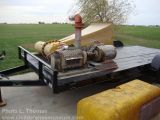
A prototype version capable of a "yelp" signal was demonstrated, and eventually sold to an ACA/Klaxon dealer in South Africa. This was the only known three-signal MKI unit ever known to be produced, though there is speculation that more existed elsewhere. The rotator could also be specially ordered with a mechanism that allowed the horn to oscillate within a specific range, similar to a Whelen WPS-3000 or 4000, instead of rotating 360 degrees. This likely used a similar oscillating mechanism to the oscillating variant of the Alertronic AL-6000R.
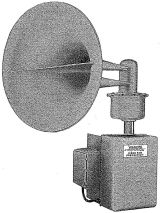
Hurricane 130 MKII
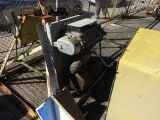
In 1973, the siren underwent a massive overhaul, called the "Hurricane 130 MKII" by ACA. The square horn was replaced with a much larger round exponential horn ending in two throats, which performed significantly better and was easier to produce. In addition, the rotator would be redesigned again, now being completely stationary, and now in a teardrop shape. The rotator used a 1/4 hp Dayton AC gear reduction motor, and rotated the horn at 2.5 RPM. The blower would also be significantly redesigned, now being vertically mounted to the side of the siren's pole. The direct-drive blower was replaced by a belt driven blower, driven by a 30 hp AC motor, and the controls were separated from the blower, now being housed in their own separate cabinet. The blower's output was identical to the MKI, at 450 cfm at 10 psi. The blower is an off-the-shelf 4012-series MD Pneumatics unit with a sub-spec indicating horizontal mounting orientation. The MKII Hurricane used a much simpler chopper assembly, with a basic dual rotor/stator setup mounted on the ends of an off-the-shelf 1 hp Doerr motor, making rotor swaps, bearing swaps, and general maintenance much easier. These changes significantly improved the siren's performance and reliability, allowing it to reach its full 130 decibel rating. This would ultimately be the design the siren would use until its discontinuation.
The Hurricane could come in 2, 3, or even 5-signal models, utilizing slide-valve solenoids to cut off the output from one or both of the choppers. This would allow the siren to create hi-lo, pulse, or even alternating wail signals depending on what the customer desired. The exact appearance and design of these coded Hurricanes are unknown, as none are known to have been documented and none survive today. The solenoids were made by Trombetta Corp., situated in Menomonee Falls. It is likely placed in between the two throats completely hidden without a external box for the solenoids unlike the Thunderbolt 1003s.
The corporation continued production of the Hurricane until 1980, when it was replaced in ACA's lineup with the significantly more powerful 50 hp ACA Penetrator-50, which proved to be both louder, and more reliable without the need for a blower. These sirens often suffered from reliability issues often due to poor maintenance, due to their complexity. This often led to their replacement as it was decided the sirens were too expensive to maintain.
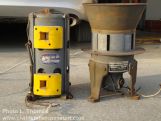
Cities which have/had Hurricanes
| Cities Using Or That Have Used The ACA Hurricane | Number of Sirens, Operation Status | Model |
|---|---|---|
| Addyston, OH | 1, Removed, in private possession | 130 MKII |
| Baxter, MN | 1, Removed, broke down in late 2007 and was replaced. Confirmed scrapped in 2022 | 130 |
| Normal, IL | 2 (Exact number unknown), Removed | 130 MKII |
| Crystal River, FL | 1 (Exact Number Unknown), Removed | 130 MKII |
| Centralia, IL | 1, Removed In 2010, Recently changed ownership into the hands of a collector in Michigan. | 130 |
| Darien, IL | 2, both removed as of May 29, 2021. 1 atop fire station removed & replaced in May 2021. The earliest one removed reportedly is in private posession; while the fire station one is in possession of the vendor. | 130 MKII |
| Garland, TX | 4, Removed | 130 MKII |
| Greendale, WI | 1, Removed | 130 MKII |
| Greenville, TX | 2, Removed. Sold at auction in 2023 to private collectors. | 130 MKII |
| La Crescent, MN | 3, all removed. 1 replaced by a Sentry 10V at an unknown date, one was removed when a water slide was built in its place, and the last one was replaced in 2015. | 130 MKII |
| Milwaukee, WI | 2, 1 operational. The other one is stored at the American Signal Corporation Headquarters. More were installed in the city at one time. | 130 MKII |
| Rolling Meadows, IL | 3, replaced in the 1980s with Alertronics | 130 |
| Bridgman, MI | 9, removed in 2000. Installed for the Donald C. Cook Nuclear Power Plant in 1982. | 130 MKII |
| Oak Harbor, OH | 5, all removed. Originally installed in 1981 for the initial phase of the Davis-Besse NPP System. Sirens had issues and were replaced with 39 Thunderbolts in 1982 for a main system. Legacy system was replaced with 2001-SRNs in 2000. | 130 MKII |
| Minnetonka, MN | 6, removed in mid 1990's and replaced with 2001-SRNs. | 130 |
| Elk Grove Village, IL | 4, all removed. One was mounted on a water tank and was replaced by a P-50. | 130 |
| DeKalb, IL | 3, all removed. Replaced by 2001s in 1989 due to partial system failure during tornado warning. | 130 |
